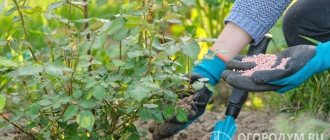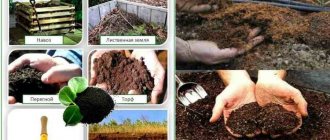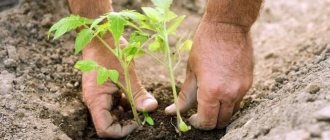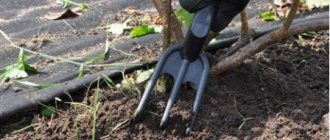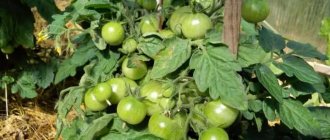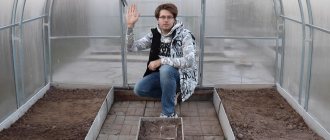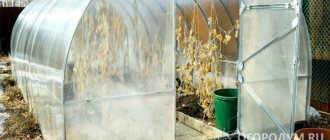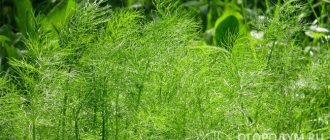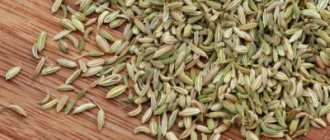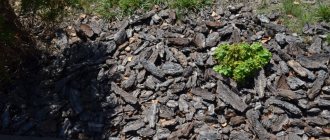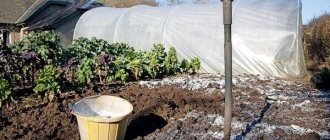How to properly feed roses and what fertilizers to use? Mineral? Organic?
- Mineral or organic fertilizers are better for roses Organic fertilizers
- Mineral supplements
- How to use manure to feed roses
- FIRST FEEDING OF ROSES (APRIL)
Mineral or organic fertilizers are better for roses
Organic fertilizers
They contain nitrogen and, if used wisely, do not harm the soil structure. They are introduced during the period of growth and flowering, during the autumn digging of the soil. During the period of preparing plants for winter, organic fertilizers are not given to roses.
Mineral supplements
They act purposefully and quickly, but can salinize the soil and inhibit the root system of plants.
As a golden mean, it is often recommended to combine mineral and organic fertilizers. It is convenient to use complex organic-mineral fertilizers, in which the quantitative ratio of elements is observed.
Summarize
In order for roses to develop well and bloom luxuriantly throughout the season, of course, they need to be fertilized. We talked about how to feed roses in the spring for growth and lush flowering in the garden in this article.
It is better to alternately use organic and mineral fertilizers. And in no case should you try to overfeed the plants by applying an excessive amount of fertilizer according to the principle “you can’t spoil the porridge with oil.”
For example, too much nitrogen fertilizer will lead to active growth of green mass, but will delay the formation of buds.
Everything needs to be done in moderation and in a timely manner. Then the roses will definitely respond to your care and delight you with their magnificent blooms.
Best regards, Alexander Tkachenko.
Natural organic fertilizers for roses
Organic fertilizers include manure, compost, lowland peat (high-moor peat is usually used for mulching and closed ground), green manure plants, and infusions of fermented herbs.
How to use manure to feed roses
“Manure has long remained the main fertilizer. Cow manure is dense and slowly decomposes, horse manure is porous, it contains more nutrients, and accordingly, its consumption rate is less. Bird droppings are fast-acting and contain nutrients in a more concentrated form that is easily accessible to plants. It is undesirable to use fresh manure: it causes increased growth of green mass, increases the sensitivity of roses to diseases and pests, and moreover, it can burn the roots. For fertilizing, rotted manure is used or infusions are prepared from fresh manure. Chicken manure is diluted in water at a rate of 1:20, cow manure - 1:10. The mixture is kept for 7–10 days in the open air. Before use, mullein is diluted by half, the infusion from the litter is diluted in a ratio of 1:3.
How to use kitchen scraps to feed roses
“Kitchen waste has long been adapted by gardeners for compost fertilizers; the most advanced ones use vermicompost. In this case, organic matter is processed by earthworms, as a result, the content of humates increases compared to the addition of rotted manure.
Humic preparations for feeding roses
“Preparations based on humic substances obtained from oxidized brown coal (leonardite), peat, sapropel, and microbiological preparations containing microorganisms are becoming increasingly popular. Such fertilizers are environmentally friendly, but they will not become a magic wand - they will act quickly and effectively on cultivated soils, where conditions have already been created for the life of microorganisms.
Using wood ash to feed roses
Wood ash is an affordable organic fertilizer that contains potassium, calcium, magnesium, iron, phosphorus, and sulfur. It is used in the form of a solution (30 g per 10 liters of water) and in dry form (200 g per 1 sq. m), embedded in the soil.
Feeding roses with organic matter
Folk recipes
Of the variety of folk recipes, agricultural technicians approve and consider the following effective for roses:
- infusion of banana peels - dry the banana peels and fill them with water, after 2-3 days the fertilizer is ready;
- yeast starter - add 30 g of yeast to three liters of water and leave to ferment for a couple of hours, then dilute it twice with water and use it for its intended purpose;
- decoction of onion peels - pour an arbitrary amount of onion peels with water and bring to a boil; when the decoction has cooled, sprinkle the rose leaves with it.
Related article:
Falcon fungicide - instructions for use of the drug for grapes
Yeast starter will fill the soil with beneficial bacteria and reduce the number of pathogenic ones. An infusion of banana skins will enrich the soil with potassium, magnesium, calcium, iron and sodium. A decoction of onion peels not only fertilizes, but also repels various pests. All these substances can be added “without time” - they are safe and there cannot be an overdose.
Mineral fertilizers for roses
When purchasing mineral fertilizers, pay attention to the composition of the drug. Roses need not only nitrogen-phosphorus-potassium, but also trace elements such as iron and magnesium. Iron provides a beautiful rich shade of flowers, magnesium provides leaves; with a lack of these microelements, plants develop chlorosis. Recently, long-acting mineral fertilizers, which are applied once in the spring, have become popular. These are granules in a special shell, from which nutrients are uniformly released into the soil over several months. Typically, the concentration of NPK in such fertilizers is high, but the substances are released gradually under the influence of temperature, water and light.
How to understand whether feeding is needed and what is missing?
Feeding roses is necessary for the formation of voluminous and healthy buds in large quantities. Bushes constantly need nitrogen, which stimulates the growth of shoots and green mass. And also - potassium for immunity and moisture exchange, phosphorus for healthy flower stalks and buds, magnesium - for laying buds.
Sure signs of nitrogen deficiency are yellowness and poor growth of leaves, small weak shoots, and slow growth. With a phosphorus deficiency, the leaves turn blue or purple, become smaller, and the bush may stop blooming. Due to a lack of potassium, the rose weakens, the shoots become short, and the buds become crooked and deformed.
Photo: zen.yandex.ru
Iron deficiency leads to chlorosis of young leaves, when the plate turns yellow, but the veins remain bright. A lack of magnesium first appears on older leaves, which begin to turn yellow and die between the veins. A lack of calcium leads to the death of shoot tips and deformation of young foliage.
In spring, roses need nitrogen and phosphorus supplements, and you definitely can’t go wrong here. But the main thing is to follow the schedule and proportions, because an imbalance of beneficial microelements leads to the death of the flower, as does their lack. Do not overuse additives and microelements unless the rose shows signs of deficiency.
Photo: farmer.blog
Rules for fertilizing roses
“Before fertilizing with mineral fertilizers and after it, the soil is watered generously. “In cold weather, it is better to do foliar feeding on leaves and shoots: infusion of mullein, bird droppings, herbs, sodium humate, complex mineral fertilizers.
“If in spring the temperature does not rise above +5 °C, there is no need to rush: the soil is not warmed up, fertilizers will be absorbed slowly and can even harm roses, which are not yet trying to grow. It is recommended to wait until the temperature is +10…+15 °C. „
It is quite possible to grow roses on organic matter alone, the main thing is not to forget some practical considerations: follow the application rates, do not leave manure on the surface, but incorporate it into the soil when digging or apply it locally, sow green manure, mulch the plantings.
Applying complex mineral fertilizer to a rose bush
Autumn
Wanting to feed the roses in August, the gardener helps the plant begin the transition to wintering. Moreover, after flowering, flowers need rest, and the growing season ends.
But already at the end of July, throughout August and a little in September, the laying of future inflorescences continues. In other words, autumn fertilizers applied will help to obtain beautiful pink buds, and will also strengthen the plant’s immunity for:
- quiet winter;
- future awakening without any problems;
- preservation of roots during severe soil freezing.
Need to know! You also need to fertilize roses in the fall because of wintering insects in the roots and fallen leaves. Infections and fungal spores hide here. Frosts and soil freezing are not a problem for them. In winter, no fertilizing is applied.
What will help
If phosphorus is desired after the first flowering, then after the petals have completely fallen, roses need potassium. Solutions offered:
- boric acid (2.5 g) + superphosphate (25 g) + potassium sulfate (10 g). The resulting mixture is diluted in a small amount of water and brought to 10 l;
- potassium monophosphate (16 g) + superphosphate (15 g). Dilute in 10 liters in the same way as the previous version of the complex substance.
To avoid mistakes when combining several components, there is always the option of using complex ready-made tools. But in all cases, the exact dosage and dilution principle are observed.
THE MOST EFFECTIVE MODERN FERTILIZERS FOR ROSES
Microbiological fertilizer Azotovit for roses, Industrial Innovations
Highly concentrated fertilizer in liquid form based on soil bacteria (Azotobacter chroococcum). Bacteria fix atmospheric nitrogen that is inaccessible to the plant, converting it into forms that are easy to assimilate. Stimulates the development of the vegetative system, the growth of new shoots and buds, and increases the color intensity of flowers and leaves. Prevents the development of fungal diseases. 30 ml of the drug is dissolved in 10 liters of settled water, watered on moist soil, on 3–4 bushes. Shake before use.
Mineral granulated fertilizer for roses Gloria, FASCO
Prolonged action. Produced using new technology - each granule contains the same composition of nutrients: NPK (5:9:5), magnesium, calcium. During the main application, the fertilizer must be evenly scattered over the soil surface and plowing, digging or loosening must be carried out. When adding fertilizer to the top dressing, distribute it evenly over the entire area, followed by embedding, loosening or digging up half a piece, and water the soil if necessary.
Fertilizer for roses and chrysanthemums, Bona Forte
Liquid complex fertilizer in a convenient 1.5 liter plastic canister. Contains NPK (3:4:8), magnesium, microelements in chelated form. For active budding and abundant, long-lasting flowering, succinic acid and a specially selected complex of vitamins are added to the composition. Roses are fed from early spring to mid-July 1 time/10–15 days, and it is recommended to combine root and foliar feeding. One canister is enough to fertilize up to 400 rose bushes.
Organomineral granular fertilizer for roses, Fertika
Fertilizer with 18% humate content, NPK (8:6:10). Each granule of the mixture contains a complete balanced set of macro and microelements necessary for normal growth and development of plants. Basic application: 100–150 g per planting hole. Feeding: in early spring and after flowering, 30–40 g per bush. Watering: 30–40 g per 10 liters of water.
Fertilizer for roses, Pokon
The balanced mixture is specially formulated for rose gardens on terraces and balconies, so that the roses bloom luxuriantly for a long time. The fertilizer contains a solution of nutrients with a ratio (NPK 8:5:5), as well as iron and magnesium. Used after each pruning and flowering in a proportion of 10 ml per 1 liter of water.
When to feed
It should be remembered that roses planted in the same year do not need to be fertilized. They will have enough nutrients in the prepared soil substrate.
Fertilizer application for plants of the second and subsequent years should begin when the weather is favorable - without precipitation.
When first feeding, the plant should be in the leaf budding phase. This approximately occurs in mid-April. Before applying fertilizers, prune rose bushes.
Typically, the first two feedings are carried out with nitrogen-containing fertilizers, and starting from the third, a preparation with a complex composition is used. The third feeding occurs during the period of bud setting.
In hot weather, the process of feeding plants is carried out in the early morning or evening, in order to avoid weakening and damage to the plant. During the flowering period of roses, fertilizing cannot be carried out.
READ ALSO: What flowers to plant in the shade at your summer cottage
After each application of fertilizer, the roses are monitored for two weeks. Too rapid growth and intense leaf color is a signal of reducing the dose of fertilizer applied.
